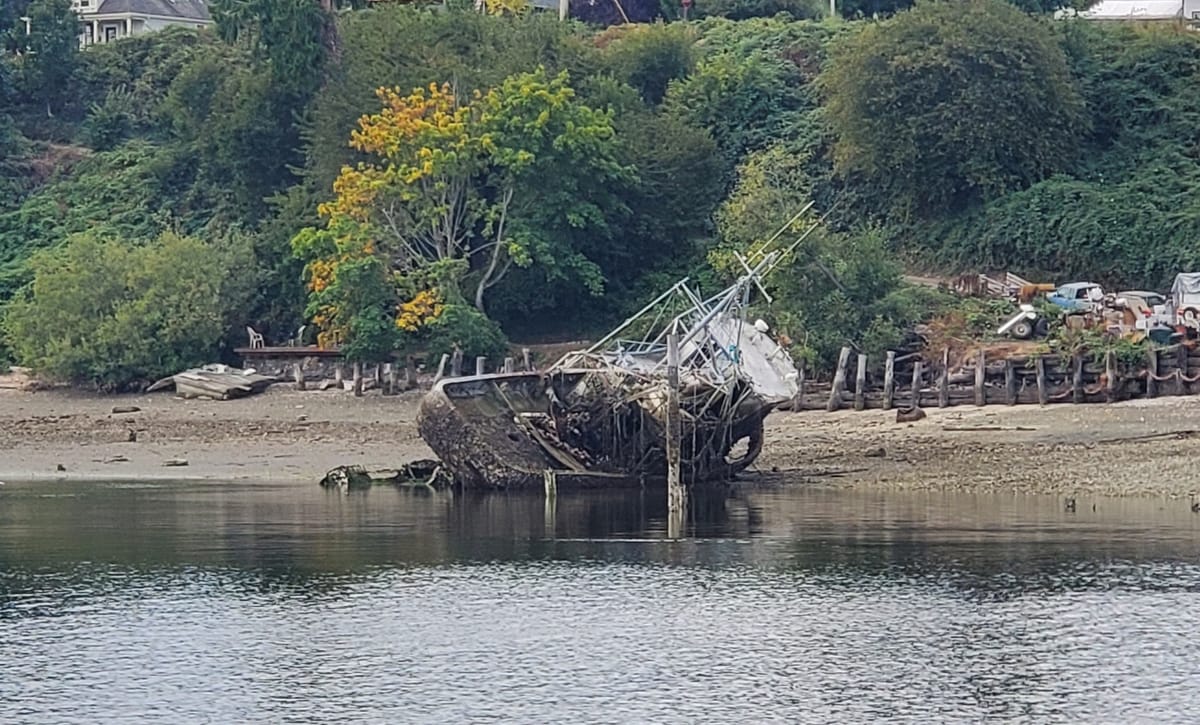Our old boats
The modern problem of derelict boats.

On a recent Friday afternoon, Andrew and I heard a flurry of sirens go by our Ballard office. More than a typical response, we looked it up in the dispatch log: a boat sinking at Shilshole Bay Marina.
We live at Shilshole and fortunately this boat was not ours nor did it belong to anyone we know. I heard it described by other tenants as an “old wooden sailboat.” There was no one injuried and the voluminous response from the Seattle Fire Department, Port of Seattle and U.S. Coast Guard seemed primarily concerned with fuel containment.
Shilshole Bay Marina is home to some neglected boats — one on our dock has a plant growing out of it — but we’ve observed even more derelict boats at other bays, marinas and piers. Vessels in various condition have also been abandoned at both Shilshole Bay Marina’s pumpout docks and the nearby City of Seattle boat ramp.
Derelict vessels are an issue all around Puget Sound. Its become an increasing expense for Washington state as well; $2.5 million in funding has been allocated to the Department of Natural Resource’s Derelict Vessel Removal program for 2021-2023. As of September, the DNR program lists 312 “vessels of concern” around the state. It seems like our old boats will continue to be an issue for years to come.
The general problem — that old boats are not maintained for various reasons — is not new, but the scale and materials involved make it a modern problem.
What are we going to do about all these old boats?
At one place I worked, the staff cut old sailing dinghies in half and stood the bows upright on a nearby grassy hill creating an unsanctioned “boathenge.” Eventually, as there was capacity, both the diced up bows and sterns went into the dumpster. This solution isn’t great.
In a few cases, the high cost of new vessels and a commitment to a vessel’s heritage, has prompted reinvestment in declining vessels.
Kitsap Transit spent more than $1 million to restore Carlisle II, one of two remaining Mosquito Fleet vessels, and continue operating it as a local foot ferry between Bremerton and Port Orchard. Historical significance aside, the cost to replace the ferry was estimated to be $8 million.
The Western Flyer was literally revived from the depths, extensively restored and after being repowered will begin a new era as a platform for science education.
Commercial, fishing and luxury vessels are often refitted again and again. A friend recently brought up shipyards that turn one into the other: container ships are reimagined as luxury havens.
The U.S. Coast Guard has even gotten creative, parting out one decommissioned heavy icebreaker to sustain the other, the Polar Star, as they await additions to this particular fleet. The “parts donor” ship Polar Sea sits near the mouth of the Duwamish River at the Coast Guard’s Seattle base. Both ships are from the 1970s.
But parting out or repurposing boat parts simply doesn’t work for most owners trying to maintain their boats.
Second-hand marine stores have come and gone in the Puget Sound region, there’s currently one in Poulsbo and one in Port Townsend. When it comes down to it though, new parts are inexpensive, made with newer materials and often fix design issues of decades past.
However, scale comes into play and there may simple be too many boats. Or too many boats that are made with older materials, unserviceable systems or dated designs. Around the Buoy, a podcast out of Rhode Island hosted by a fellow Oregon Sailing alum, did a two-part episode about fiberglass boat recycling and the growing problem of aging fiberglass boats.
This challenge exists for small craft — only so many can be turned into a planter boxes — to production sail and power boats popularized in the ‘70s and ‘80s to ferries on up to cargo vessels.
What solutions might we see in the next couple of decades? Will disposal methods improve? Who will shoulder that burden? Will new construction consider disposal, in the vein of Extended Producer Responsibility laws that are trying to address plastic waste? Will the maritime community doubledown on its refit heritage?
This is what I wonder about our old boats.
